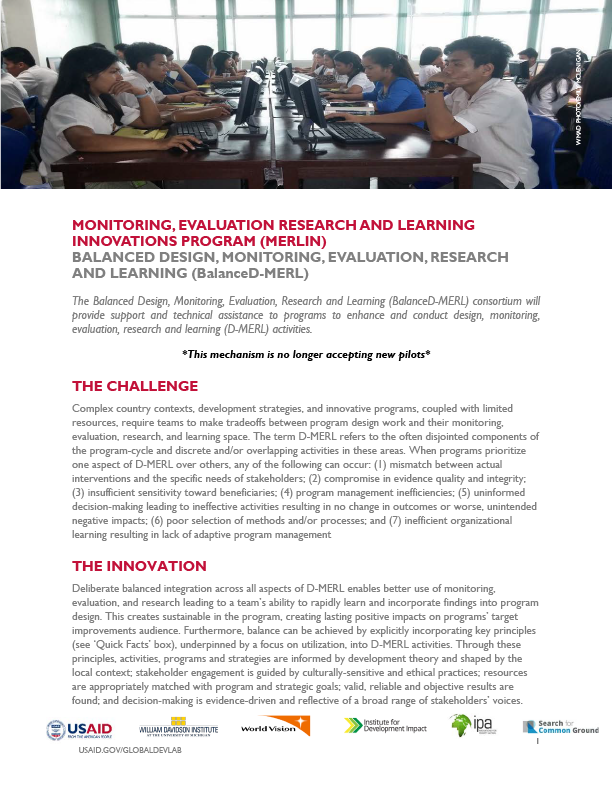- What We Do
- Agriculture and Food Security
- Democracy, Human Rights and Governance
- Economic Growth and Trade
- Education
- Environment and Global Climate Change
- Gender Equality and Women's Empowerment
- Global Health
- Humanitarian Assistance
- Transformation at USAID
- Water and Sanitation
- Working in Crises and Conflict
- U.S. Global Development Lab
Speeches Shim
*No Longer Accepting New Pilots*
The Balanced Design, Monitoring, Evaluation, Research and Learning (BalanceD-MERL) consortium will provide support and technical assistance to programs to enhance and conduct design, monitoring, evaluation, research and learning (D-MERL) activities.
The Challenge
Complex country contexts, development strategies, and innovative programs, coupled with limited resources, require teams to make tradeoffs between program design work and their monitoring, evaluation, research, and learning space. The term D-MERL refers to the often disjointed components of the program-cycle and discrete and/or overlapping activities in these areas. When programs prioritize one aspect of D-MERL over others, any of the following can occur: (1) mismatch between actual interventions and the specific needs of stakeholders; (2) compromise in evidence quality and integrity; (3) insufficient sensitivity toward beneficiaries; (4) program management inefficiencies; (5) uninformed decision-making leading to ineffective activities resulting in no change in outcomes or worse, unintended negative impacts; (6) poor selection of methods and/or processes; and (7) inefficient organizational learning resulting in lack of adaptive program management.
The Innovation
Deliberate balanced integration across all aspects of D-MERL enables better use of monitoring, evaluation, and research leading to a team’s ability to rapidly learn and incorporate findings into program design. This creates sustainable improvements in the program, creating lasting positive impacts on programs’ target audience. Furthermore, balance can be achieved by explicitly incorporating key principles (see ‘Quick Facts’ box), underpinned by a focus on utilization, into D-MERL activities. Through these principles, activities, programs and strategies are informed by development theory and shaped by the local context; stakeholder engagement is guided by culturally-sensitive and ethical practices; resources are appropriately matched with program and strategic goals; valid, reliable and objective results are found; and decision-making is evidence-driven and reflective of a broad range of stakeholders’ voices.
The Approach
By engaging in a guided assessment process and technical assistance, the consortium, leveraging its expansive technical capabilities, will help USAID programs achieve balanced integration of D-MERL practices and principles as well as build staff capacity in the same. BalanceD-MERL will be incorporated into a program through a series of steps beginning with a program’s self-diagnosed assessment to provide a preliminary analysis of its balance. This will be followed by an in-depth field assessment, conducted by the consortium, to identify where and how the program can be adjusted to increase balance and enable efficient and effective utilization of D-MERL recommendations. The final step will consist of field-based technical assistance by the consortium to implement the developed recommendations.
Quick Facts
- Principles: Relevant, Responsible, Right-sized, and Trustworthy
- Funding mechanism: Cooperative Agreement (buy-in option for USAID operating units)
- Partners: World Vision (prime), Innovations for Poverty Action, Institute for Development Impact, Search for Common Ground, The William Davidson Institute at the University of Michigan
- Period of Performance: 10/01/2015 – 9/30/2019


Comment
Make a general inquiry or suggest an improvement.